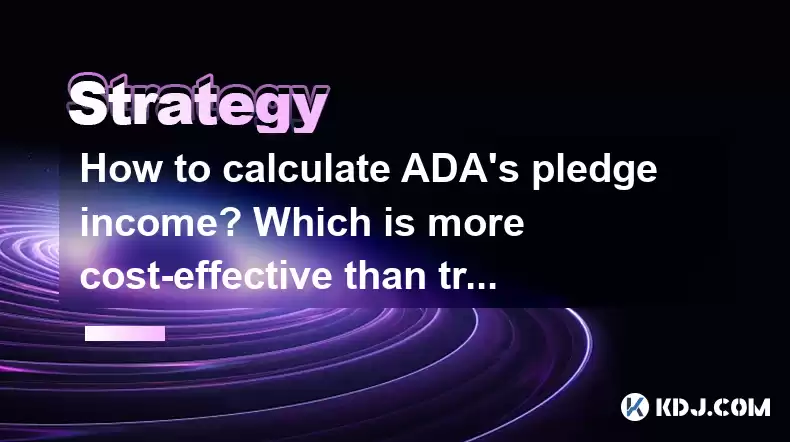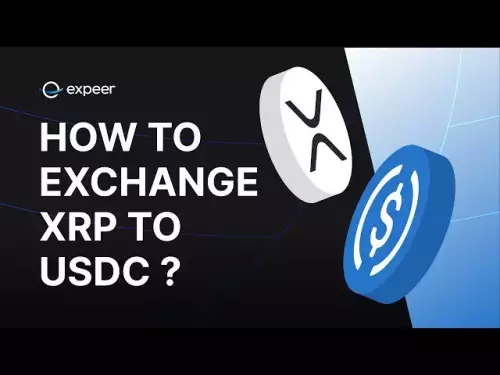-
 bitcoin
bitcoin $112715.707551 USD
-1.71% -
 ethereum
ethereum $4101.475385 USD
-3.01% -
 tether
tether $1.000644 USD
-0.02% -
 bnb
bnb $1207.619465 USD
-6.77% -
 xrp
xrp $2.501451 USD
-3.98% -
 solana
solana $202.947124 USD
-3.32% -
 usd-coin
usd-coin $1.000295 USD
0.04% -
 dogecoin
dogecoin $0.203884 USD
-4.47% -
 tron
tron $0.317154 USD
-1.72% -
 cardano
cardano $0.695009 USD
-4.43% -
 hyperliquid
hyperliquid $38.853961 USD
-8.23% -
 chainlink
chainlink $18.988674 USD
-4.64% -
 ethena-usde
ethena-usde $1.000233 USD
-0.03% -
 stellar
stellar $0.337050 USD
-3.63% -
 bitcoin-cash
bitcoin-cash $536.861728 USD
-1.28%
How to calculate ADA's pledge income? Which is more cost-effective than trading?
Calculating ADA pledge income involves staking rewards, pool performance, and costs; it's a passive, low-risk income compared to the higher potential returns and risks of trading.
Apr 29, 2025 at 11:35 am

Calculating ADA's pledge income and understanding its cost-effectiveness compared to trading is crucial for Cardano enthusiasts. Pledge income, or staking rewards, is a passive income stream that can be earned by holding and staking ADA tokens. This article will guide you through the process of calculating your ADA pledge income and discuss its cost-effectiveness relative to trading.
Understanding ADA Staking
ADA staking is the process by which Cardano users lock up their tokens to support the network's operations and, in return, receive rewards. The Cardano blockchain uses a Proof of Stake (PoS) consensus mechanism, where the more ADA you stake, the higher your chance of being chosen to validate transactions and earn rewards.
To start staking, you need to delegate your ADA to a stake pool. A stake pool is a server or group of servers operated by a Cardano community member or group that processes transactions and maintains the integrity of the blockchain. When you delegate your ADA to a stake pool, you are essentially lending your ADA to that pool to increase its chances of being chosen to validate transactions.
Calculating ADA Pledge Income
To calculate your ADA pledge income, you need to consider several factors: the total amount of ADA you stake, the pool's performance, the pool's cost, and the pool's margin. Here's how you can do it:
- Total ADA Staked: This is the amount of ADA you delegate to a stake pool.
- Pool Performance: This is measured by the pool's saturation level and its ability to produce blocks. A pool's performance can be found on Cardano block explorers like CardanoScan or PoolTool.
- Pool Cost: This is a fixed fee that the pool operator charges for running the pool, usually around 340 ADA per epoch.
- Pool Margin: This is the percentage of the rewards that the pool operator keeps before distributing the rest to delegators.
The formula to calculate your ADA pledge income per epoch is as follows:
[ \text{Reward} = (\text{Total Rewards} - \text{Pool Cost}) \times (1 - \text{Pool Margin}) \times \frac{\text{Your ADA Staked}}{\text{Total ADA in Pool}} ]
Let's break it down:
- Total Rewards: The total amount of ADA rewards distributed to the pool for the epoch.
- Pool Cost: Subtracted from the total rewards.
- Pool Margin: The remaining rewards after subtracting the pool cost are then reduced by the pool margin.
- Your ADA Staked: Your share of the remaining rewards is proportional to the amount of ADA you have staked relative to the total ADA in the pool.
Example Calculation
Let's assume you stake 10,000 ADA in a pool with a total of 1,000,000 ADA staked. The pool's performance is high, and it earns 10,000 ADA in rewards for the epoch. The pool's cost is 340 ADA, and the pool's margin is 5%.
- Calculate the rewards after pool cost: (10,000 - 340 = 9,660) ADA.
- Calculate the rewards after pool margin: (9,660 \times (1 - 0.05) = 9,177) ADA.
- Calculate your share of the rewards: (\frac{10,000}{1,000,000} \times 9,177 = 91.77) ADA.
So, for this epoch, you would earn approximately 91.77 ADA.
Comparing Staking to Trading
Staking ADA offers a passive income stream, which can be more cost-effective than active trading for several reasons:
- Lower Risk: Staking involves less risk than trading, as you are not subject to the volatility of the market. Your rewards are relatively predictable and consistent.
- Lower Costs: Staking incurs minimal costs, primarily the pool's fixed fee and margin. Trading, on the other hand, involves transaction fees, slippage, and potential losses due to market fluctuations.
- Time Commitment: Staking requires minimal time and effort once set up, whereas trading requires constant monitoring and decision-making.
However, trading can potentially yield higher returns if executed successfully. It involves buying and selling ADA based on market trends and analysis, which can be lucrative but also comes with higher risks and costs.
Setting Up ADA Staking
To start staking ADA, follow these steps:
- Choose a Wallet: You need a Cardano-compatible wallet that supports staking. Popular options include Daedalus and Yoroi.
- Fund Your Wallet: Transfer your ADA to the wallet.
- Select a Stake Pool: Research and choose a stake pool based on its performance, cost, and margin. You can find this information on Cardano block explorers.
- Delegate Your ADA: In your wallet, navigate to the staking section, select your chosen pool, and delegate your ADA to it.
Here's a detailed guide for setting up staking using the Daedalus wallet:
- Download and Install Daedalus: Visit the official Cardano website and download the Daedalus wallet for your operating system.
- Sync the Wallet: After installation, open Daedalus and let it sync with the Cardano blockchain. This might take some time.
- Create or Restore a Wallet: Follow the prompts to create a new wallet or restore an existing one using your recovery phrase.
- Transfer ADA: Send your ADA to the wallet address provided by Daedalus.
- Navigate to Staking: Once your ADA is in the wallet, go to the 'Delegation' tab.
- Select a Stake Pool: Use the search function to find a stake pool. Consider factors like performance, cost, and margin.
- Delegate ADA: Click on the pool you want to delegate to, review the details, and confirm the delegation. Your ADA will be locked in the pool, and you'll start earning rewards from the next epoch.
Monitoring and Adjusting Your Staking Strategy
Once you've set up staking, it's important to monitor your rewards and the performance of your chosen stake pool. You can do this through your wallet or by using Cardano block explorers. If you find that your pool's performance is declining or if you find a better pool, you can redelegate your ADA to a new pool.
- Check Rewards: Regularly check your wallet to see the rewards you've earned.
- Evaluate Pool Performance: Use Cardano block explorers to assess the performance of your stake pool.
- Redelegate if Necessary: If you find a better pool, you can redelegate your ADA. This process takes effect from the next epoch.
Frequently Asked Questions
Q: Can I stake ADA from an exchange?A: Some exchanges offer staking services for ADA, but the rewards are usually lower compared to staking directly from a personal wallet. Additionally, you don't have control over which pool your ADA is delegated to.
Q: What happens to my ADA if I stop staking?A: If you stop staking, your ADA is returned to your wallet, and you can use it as you wish. You won't receive any more staking rewards until you start staking again.
Q: How often are staking rewards distributed?A: Staking rewards on the Cardano network are distributed at the end of each epoch, which lasts approximately five days.
Q: Is there a minimum amount of ADA required to stake?A: There is no minimum amount of ADA required to stake, but the more ADA you stake, the higher your potential rewards. However, the rewards are also influenced by the total ADA staked in the pool you choose.
Disclaimer:info@kdj.com
The information provided is not trading advice. kdj.com does not assume any responsibility for any investments made based on the information provided in this article. Cryptocurrencies are highly volatile and it is highly recommended that you invest with caution after thorough research!
If you believe that the content used on this website infringes your copyright, please contact us immediately (info@kdj.com) and we will delete it promptly.
- Tokenization Takes Center Stage: SEC-Registered Stock Tokens Reshape Finance
- 2025-10-15 22:25:13
- Bitcoin Seized, Transferred: A New York Minute on Crypto's Wild Ride
- 2025-10-15 22:25:13
- Milk & Mocha's $HUGS: Can This Crypto Presale Deliver a 100x Portfolio?
- 2025-10-15 22:30:01
- Memecoins Grow Up: $HUGS Presale Offers Real Utility
- 2025-10-15 22:45:13
- HUGS Launch, Crypto Bull Run, and a Perfect Storm Brewing?
- 2025-10-15 22:45:13
- Zero Knowledge Proof, Whitelists, and the Future of Blockchain Privacy
- 2025-10-15 22:30:01
Related knowledge

Practical parameter settings for a Bitcoin multi-timeframe moving average system
Sep 18,2025 at 10:54pm
Optimizing Timeframe Combinations for Bitcoin Trading1. Selecting appropriate timeframes is crucial when building a multi-timeframe moving average sys...

How can I filter out false breakouts in Dogecoin high-frequency trading?
Sep 22,2025 at 01:00am
Understanding False Breakouts in Dogecoin Trading1. A false breakout occurs when Dogecoin's price appears to move beyond a defined support or resistan...

Techniques for identifying tops and bottoms in the Bitcoin on-chain NVT model
Sep 20,2025 at 07:54pm
Understanding the NVT Model in Bitcoin Analysis1. The Network Value to Transactions (NVT) ratio is often described as the 'P/E ratio' of the cryptocur...

What does the surge in open interest in Bitcoincoin futures mean?
Sep 20,2025 at 11:18pm
Understanding the Surge in Dogecoin Futures Open Interest1. A surge in open interest within Dogecoin futures indicates a growing number of active cont...

How can I use the Ethereum USDT premium to gauge market sentiment?
Sep 18,2025 at 11:55pm
Understanding the Ethereum USDT Premium1. The Ethereum USDT premium refers to the price difference between USDT (Tether) traded on Ethereum-based plat...

What should I do if Ethereum staking yields decline?
Sep 20,2025 at 06:18am
Understanding the Causes Behind Declining Ethereum Staking Yields1. The Ethereum network transitioned to a proof-of-stake consensus mechanism with the...

Practical parameter settings for a Bitcoin multi-timeframe moving average system
Sep 18,2025 at 10:54pm
Optimizing Timeframe Combinations for Bitcoin Trading1. Selecting appropriate timeframes is crucial when building a multi-timeframe moving average sys...

How can I filter out false breakouts in Dogecoin high-frequency trading?
Sep 22,2025 at 01:00am
Understanding False Breakouts in Dogecoin Trading1. A false breakout occurs when Dogecoin's price appears to move beyond a defined support or resistan...

Techniques for identifying tops and bottoms in the Bitcoin on-chain NVT model
Sep 20,2025 at 07:54pm
Understanding the NVT Model in Bitcoin Analysis1. The Network Value to Transactions (NVT) ratio is often described as the 'P/E ratio' of the cryptocur...

What does the surge in open interest in Bitcoincoin futures mean?
Sep 20,2025 at 11:18pm
Understanding the Surge in Dogecoin Futures Open Interest1. A surge in open interest within Dogecoin futures indicates a growing number of active cont...

How can I use the Ethereum USDT premium to gauge market sentiment?
Sep 18,2025 at 11:55pm
Understanding the Ethereum USDT Premium1. The Ethereum USDT premium refers to the price difference between USDT (Tether) traded on Ethereum-based plat...

What should I do if Ethereum staking yields decline?
Sep 20,2025 at 06:18am
Understanding the Causes Behind Declining Ethereum Staking Yields1. The Ethereum network transitioned to a proof-of-stake consensus mechanism with the...
See all articles










































































